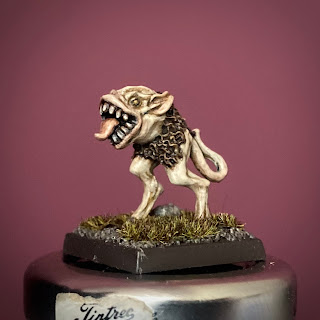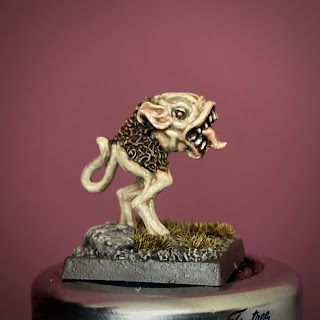The year was 1986. Channel 4 had spent several years exposing UK audiences to the bizarre and exhilarating spectacle of the NFL, William 'the Refrigerator' Perry of the Chicago Bears and Dan Marino of the Miami Dolphins were household names, and Games Workshop released the first edition of one of their most iconic board games.
Designed by Jervis Johnson, the game reimagined American Football in GW's nascent Warhammer Fantasy Battle setting, complete with bad puns, chaos spikey death bits and lashings of ultraviolence. The insanely cool box art was by Brett Ewins, known at the time to fans of 2000AD for his run on the Judge Dredd strip. It was 1986 and Blood Bowl was top of my Christmas list.

Having recently dug out my copy to administer the traditional Easter weekend Blood Bowl thrashing to the kids, I thought folks who'd missed out on this gem might be interested to see what was in the box. Along with the rulebook, you got a pitch made from 6 interlocking boards, a pad of team rosters (which I've judicially rationed for nearly 40 years), a load of cardboard counters for the teams along with 30 black plastic bases, score tracker tokens and a reversible football token for when the ball is being carried or on the deck. Not shown here is the referee token which is tossed to decide who goes first. One player flicks the token in the air while the other player calls 'dead' or 'alive'. I suspect mine's hiding down the back of the games cupboard.

For the goodies you got 15 humans (who could be used to represent the Creeveland Crescents), 15 dwarfs (the Dwarf Giants or maybe the Dwarf Warhammerers) and half a dozen Halflings (not quite enough to play the Bluebay Crammers). Stats were also given for elves.
The baddies got a team of 15 orcs (the Gouged Eye or the Severed Heads) and 15 dark elves (Darkside Cowboys). Stats were also provided for half-orcs and hobgoblins.
A couple of special teams were also included. The Chaos All-Stars are, for me, the GOAT. You got 12 fairly crappy lesser goblins, but you also got 4 ogres, who in addition to being hard as nails could throw the lesser goblins. The tactic of chucking a gobbo who's holding the ball at the opposing team's end zone has been well used down the years. Once you got bored of ogres being far too good, you could switch them out for either trolls or troglodytes. These are still tanky but suffer from stupidity.
For the Champions of Death you got 10 skeletons or 10 zombies, 4 ghouls and a mummy. Rules were also provided for the Heroes of Law (humans, elves, dwarfs and halflings) and the Evil Gits (orcs, dark elves, half-orcs and hobgoblins).
As you can see, GW crammed a lot into the box and with so many teams available the game had lots of replayability. It was also a hit. Such was the enthusiasm for the game an expansion set, Death Zone, was released early the following year. I lost my Death Zone box many moons ago, but fortunately I still have the rulebook and all the extra bits.
The rulebook tidied up some of the rules from the original game, resulting in smoother gameplay. Optional rules included new special players (chuckers, catchers, runners, defenders and kickers), pitch invasions and magic. A great deal of the rulebook was dedicated to a campaign system for running leagues. This introduced elements such as buying players and paying wages, arranging assassinations, bribes, performance enhancing drugs, sponsorship deals and cheerleaders.
Death Zone came with green, red, yellow and blue plastic bases for tracking special players on the pitch (which are massively helpful) as well as a load of new teams. First up were the teams missing from the original game - elves, half-orcs and hobgoblins. A further 9 halfling counters were also included. Presumably someone somewhere was desperate to field 15 of the wooly footed buggers despite them being truly awful.
Amongst the new teams came slann (Central Lustria Croakers) and goblins (Low Down Rats). The Heroes of Law got a couple of treemen for their roster while the Chaos All-Stars got some minotaurs for their big monster slot.
The Norse got a team consisting of 11 norsemen and 4 berserkers who are prone to go, well, berserk.
Another new team was the Albion Wanderers consisting of 5 knights and 10 peasants. Their special rule is Forelock Syndrome. Any player attempting to pass the ball to a peasant roles against their cool and if they fail they have to pass to a knight instead. Additionally, all knights must be moved before the peasants.
The werewolf team looks good on paper until you realise that all transformations must happen on the pitch and this takes the player out of the game for an entire turn. As the rulebook says, "They seem to perform brilliantly against skeleton teams, but have a terrible time keeping their minds on the game when playing treemen."
Nurgle's Rotters are represented by a selection of putrescent humans, elves, dwarves, orcs and halflings along with a couple of Nurgle beasts. On the upside, the Rotters can attempt to infect opposing players, causing them to switch sides once the rot reaches their brain. On the downside, the Rotters are so rotten themselves that they are prone to falling apart every time they are attacked or tackled. There is always the chance that they will be "reduced to a gibbering, pulsating, throbbing, pustulent, festering blob of diseased-ridden tissue." Several counters are provided for this eventuality.

There were also stats and rules provided for Very Special Players. Alfie Shortzenegger is a halfling player who is not quite as crap as his peers, but his devotion to the minor deity Bod-ee-bill'da has made him suffer from stupidity. Talking of stupid, Thrud the Barbarian might turn up to play if both coaches agree, although he's liable to get confused and switch sides after each score. Finally there's giant referee Galak Star-Scraper, who steams onto the pitch if he thinks there is foul play going on and then proceeds to stomp everyone until he's managed to stomp the perpetrators.
To support the release of Death Zone, the Skaven Scramblers came free with White Dwarf issue 86 (Feb 1987). The team included star players Breeet Braingulper, Skrag the Unclean, Shisk Four-Arms and Glart Smashrip along with 11 standard skaven. In true Warhammer style, the skaven also received a mutation table.
White Dwarf issue 88 would include a team of Mega City judges and a team of fatties (GW had a licence for producing Judge Dredd games at the time) , but I don't remember ever seeing this in the newsagents. It's a pretty weird tie-in, though.
So there you have it, nearly the complete Blood Bowl 1st ed. Despite the clunky mechanics (pretty much ripped straight from WFB 2nd ed.) I was obsessed with this game as a kid and it is still a treasured possession. I'd play at any given opportunity and even ran leagues for my mates. One of my friends bought Blood Bowl 2nd ed. when it was released in 1988. The new mechanics were a huge step forward and I remember being impressed by the 3D polystyrene pitch and plastic human and orc teams, but I stuck with the original. With one boxed game, one expansion set and a freebie I had all the bits and pieces I would ever need for a lifetime of playing fantasy football.
Right, enough rose-tinted reminiscing. I need to crack on with painting goblins. Laters.

.jpg)
























.jpg)



.jpg)
.jpg)











.jpg)
.jpg)























